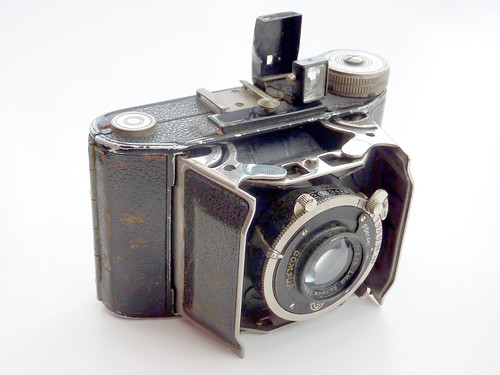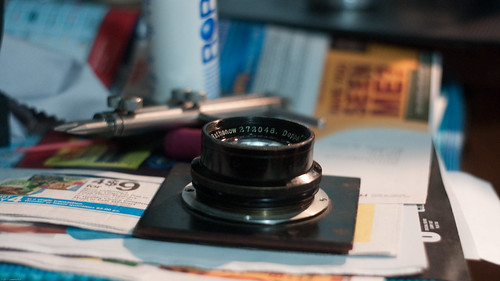Difference between revisions of "Laack"
m (wikilink to Emil Busch) |
(Added more pictures of Laack lens) |
||
| Line 1: | Line 1: | ||
__NOTOC__ | __NOTOC__ | ||
| + | {|class="floatright plainlinks" style="text-align:center;" | ||
| + | |{{Flickr_image | ||
| + | |image_source= http://www.flickr.com/photos/ladenla/5575212637/in/pool-camerawiki/ | ||
| + | |image= http://farm6.static.flickr.com/5132/5575212637_c041954184.jpg | ||
| + | |image_align= | ||
| + | |image_text= | ||
| + | |image_by= | ||
| + | |image_rights= | ||
| + | }} | ||
| + | |- | ||
| + | |{{Flickr_image | ||
| + | |image_source= http://www.flickr.com/photos/ladenla/5582572807/ | ||
| + | |image= http://farm6.static.flickr.com/5183/5582572807_0bde9d1c27.jpg | ||
| + | |image_align= | ||
| + | |image_text= | ||
| + | |image_by= | ||
| + | |image_rights= | ||
| + | }} | ||
| + | |- | ||
| + | |Laack 16.5 cm f/4.5 lens identified simply as 'Doppel Anastigmat', for a large<br/>format (probably 4×5 inch) camera. <small>Images by [[:Category: Image by Ladenla|Ladenla]] </small>{{with permission}} | ||
| + | |- | ||
| + | |} | ||
| + | |||
<div class="floatright plainlinks" style="margin:0px 0px 10px 15px;"> | <div class="floatright plainlinks" style="margin:0px 0px 10px 15px;"> | ||
{{Flickr_image | {{Flickr_image | ||
| Line 10: | Line 33: | ||
}} | }} | ||
</div> | </div> | ||
| − | '''Julius Laack Soehne''' was a camera and lens maker, based in the German town Rathenow. McKeown<ref>{{McKeown12}} p592.</ref> lists a ferrotype camera from 1895, and a number of folding plate cameras. Laack lenses were used on smaller-format cameras at least up to the Second World War. In the time of the German Democratic Republic the company became state-owned and was part of VEB Rathenower Optische Werke ('''ROW'''), together with [[Emil Busch]] and Nitsche and Gunthe<ref>[http://www.optikrathenow.de/optik/de/ge_a02.html Die Geschichte der optischen Industrie in Rathenow II] (History of the optical industry in | + | '''Julius Laack Soehne''' was a camera and lens maker, based in the German town Rathenow. McKeown<ref>{{McKeown12}} p592.</ref> lists a ferrotype camera from 1895, and a number of folding plate cameras. Laack lenses were used on smaller-format cameras at least up to the Second World War. In the time of the German Democratic Republic the company became state-owned and was part of VEB Rathenower Optische Werke ('''ROW'''), together with [[Emil Busch]] and Nitsche and Gunthe.<ref>[http://www.optikrathenow.de/optik/de/ge_a02.html Die Geschichte der optischen Industrie in Rathenow II] (History of the optical industry in Rathenow part II) at [http://www.optikrathenow.de/optik/index.html Kompetenzzentrum Optik Rathenow] (Rathenow Optics Centre)</ref> |
Laack lenses, especially the Pololyt, appear on other companies' cameras including the Altissa [[Altiflex]] and [[Altix]], Welta [[Reflekta]] and KW [[Pilot Super]]. Laack also made cine lenses. | Laack lenses, especially the Pololyt, appear on other companies' cameras including the Altissa [[Altiflex]] and [[Altix]], Welta [[Reflekta]] and KW [[Pilot Super]]. Laack also made cine lenses. | ||
| Line 23: | Line 46: | ||
* Wanderer. 6.5×9 cm folding plate camera | * Wanderer. 6.5×9 cm folding plate camera | ||
* Meteor <!-- This model isn't in McKeown: can anyone confirm it? --> | * Meteor <!-- This model isn't in McKeown: can anyone confirm it? --> | ||
| + | |||
=== Lenses === | === Lenses === | ||
Revision as of 21:24, 4 August 2011
| ||
| ||
| Laack 16.5 cm f/4.5 lens identified simply as 'Doppel Anastigmat', for a large format (probably 4×5 inch) camera. Images by Ladenla (Image rights) |

|
| Laack 5 cm f/2.7 Dialytar on a 3x4 cm camera by Glunz image by Tony Kemplen (Image rights) |
Julius Laack Soehne was a camera and lens maker, based in the German town Rathenow. McKeown[1] lists a ferrotype camera from 1895, and a number of folding plate cameras. Laack lenses were used on smaller-format cameras at least up to the Second World War. In the time of the German Democratic Republic the company became state-owned and was part of VEB Rathenower Optische Werke (ROW), together with Emil Busch and Nitsche and Gunthe.[2]
Laack lenses, especially the Pololyt, appear on other companies' cameras including the Altissa Altiflex and Altix, Welta Reflekta and KW Pilot Super. Laack also made cine lenses.
Cameras
- Ferrotype camera, c1895
- Merkur. 10×15 cm folding plate camera. Polyxentar f/6.8 lens and Koilos shutter.
- Padie. 9×12 cm folding plate camera. Pololyt f/6.8 lens and Rulex shutter.
- Sport-Camera. Folding press camera with focal plane shutter. 6.5×9, 9×12 or 10×15 cm. Dialytar lens (various maximum apertures).
- Tropical. 9×12 cm tropical folding plate camera. Pololyt or Dialytar lens and Compur or Ibsor shutter.
- Wanderer. 6.5×9 cm folding plate camera
- Meteor
Lenses
- Dialytar. This name was used on several lenses of different design and maximum aperture. Greenleaf[3] lists three designs; one is a simple triplet, one (Series T!) a Tessar-type, and one a four-element lens like a Tessar, but with the two parts of the rear group not cemented, and with an air space.
- Doppel-Polynar. A simple double-anastigmat, with two cemented doublets.[3]
- Pololyt. A simple triplet.
- Polyxentar. A double-anastigmat; either composed of two cemented triplets (f/6.8) or of two triplets with only the outermost pair of each cemented (f/4.5).[3]
- Regulyt. A simple triplet.
Notes
- ↑ McKeown, James M. and Joan C. McKeown's Price Guide to Antique and Classic Cameras, 12th Edition, 2005-2006. USA, Centennial Photo Service, 2004. ISBN 0-931838-40-1 (hardcover). ISBN 0-931838-41-X (softcover). p592.
- ↑ Die Geschichte der optischen Industrie in Rathenow II (History of the optical industry in Rathenow part II) at Kompetenzzentrum Optik Rathenow (Rathenow Optics Centre)
- ↑ 3.0 3.1 3.2 Greenleaf, Allen R. (1950) Photographic Optics. Macmillan, New York. pp82 & 201-8.
Links
- Laack 9×12 cm tropical camera with 13.5 cm Poloyt and Rulex shutter, in a past Breker auction listing (on the left of the picture).
- 1 inch f/1.3 Cine-Polyxentar cine lens, 1930s (as estimated by owner) in Japanese blog Hubbell's Photo Leaf.
- K.W. Box Reflex with a 10.5 cm f/4.5 Pololyt, at Early Photography
- Laack 13.5 cm enlarging lens at ksmt.com, the website of a Japanese lens collector (he has tried the lens for photography with a DSLR; example photos are linked from this page).

